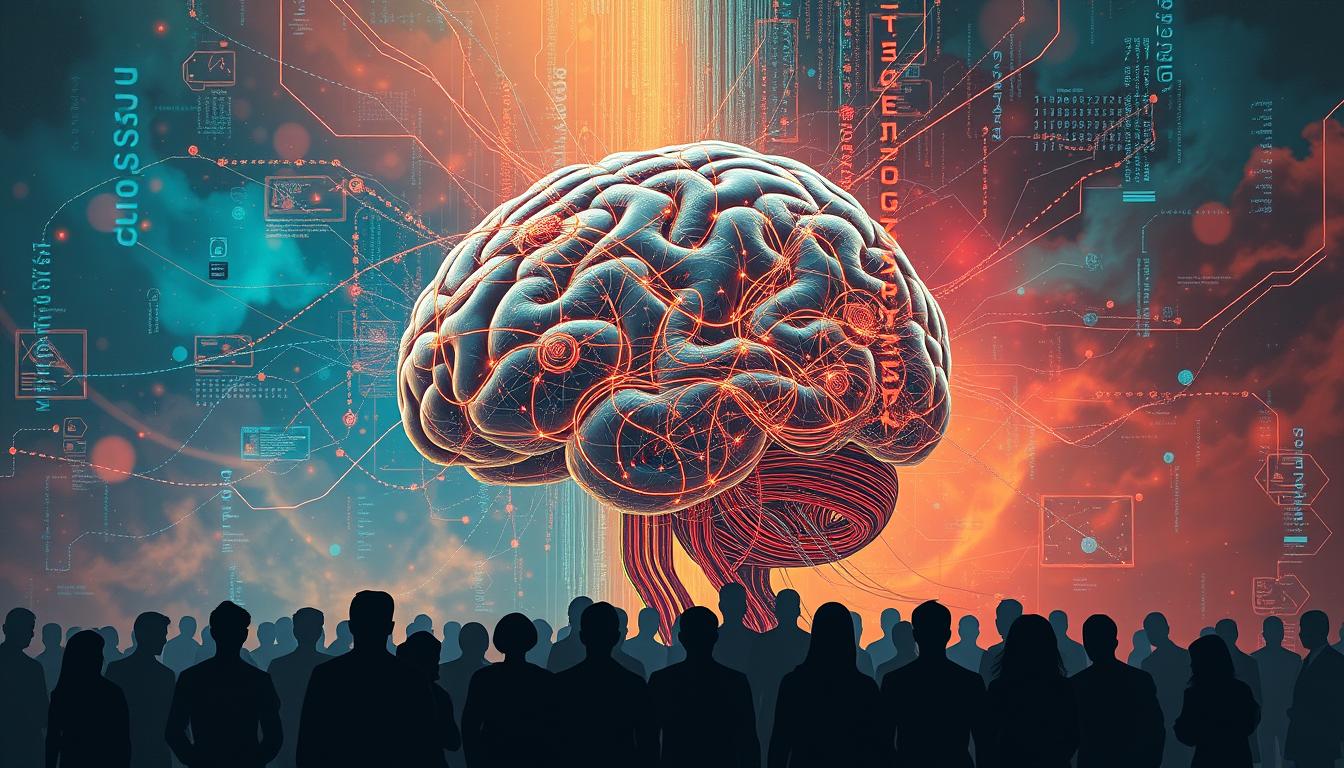YouTube’s platform dominates digital content consumption worldwide. Its success stems from the faceless YouTube channel algorithm. This complex system curates and recommends content based on various factors.
The algorithm shapes content recommendations and personalized suggestions. It also influences video visibility on the platform. Understanding its workings is crucial for content creators and marketers.
Key Takeaways
- The faceless YouTube channel algorithm is a sophisticated system that drives content recommendations and personalized suggestions on the platform.
- Understanding the key components of the algorithm, such as machine learning models, user engagement metrics, and video ranking systems, is crucial for optimizing channel and video performance.
- Addressing data privacy concerns, algorithmic bias, and transparency issues surrounding the algorithm is essential for maintaining user trust and fostering ethical content curation.
- The future of the faceless YouTube channel algorithm lies in its ability to strike a balance between technological advancements and ethical considerations, ensuring a fair and inclusive content ecosystem.
- Staying up-to-date with the evolving trends and best practices related to the algorithm can help content creators and marketers capitalize on the platform’s immense reach and audience engagement potential.
Understanding the Faceless YouTube Channel Algorithm
YouTube’s faceless algorithm is the backbone of its content ecosystem. It curates and recommends videos to users. The algorithm has become more sophisticated over time, adapting to user preferences and behavior.
What is the Faceless YouTube Channel Algorithm?
This algorithm powers YouTube’s content recommendations. It analyzes user data, including watch history and engagement metrics. The system predicts which videos a user will find engaging and relevant.
The Evolution of YouTube’s Recommendation System
- Early on, YouTube’s recommendations relied on video titles, tags, and viewer comments.
- As YouTube grew, its algorithm became more sophisticated, using advanced machine learning models for content recommendations and personalized suggestions.
- Now, the algorithm uses user behavior, video metadata, and contextual cues for personalized viewing experiences.
YouTube’s algorithm aims to keep users engaged and satisfied. It continuously refines the faceless YouTube channel algorithm to show relevant content.
This approach helps surface engaging videos for each user. It fuels YouTube’s growth and success in the digital world.
Content Recommendations: The Driving Force
The faceless YouTube channel algorithm offers personalized content recommendations. It analyzes viewing history, search patterns, and engagement metrics. This helps surface relevant videos, encouraging viewers to explore more content.
Advanced machine learning models power the algorithm’s recommendation engine. It constantly analyzes user behavior and preferences. This data-driven approach allows the algorithm to identify content that aligns with a user’s interests, ultimately driving increased user engagement and time spent on the platform.
Leveraging User Engagement Metrics
The algorithm focuses on user engagement metrics. These include watch time, video completion rates, and interaction signals. It uses this data to deliver more personalized content recommendations.
- Watch time: The algorithm favors videos that viewers watch for longer periods, as this indicates a higher level of engagement.
- Video completion rates: Videos that viewers watch to completion are seen as more engaging and are more likely to be recommended.
- Interaction signals: Factors like likes, shares, and comments provide valuable insights into user preferences and help the algorithm refine its content recommendations.
By leveraging user engagement metrics, the faceless YouTube channel algorithm can continuously improve its content recommendations, ensuring that viewers are presented with videos that capture their attention and keep them engaged on the platform.
“The key to success on YouTube is understanding how the algorithm works and using that knowledge to create content that the algorithm will promote.”
Personalized Suggestions: Tailoring the Experience
YouTube’s algorithm offers personalized viewing experiences using user data. It caters to individual preferences and habits to boost user engagement. This personalization is key to the platform’s content delivery system.
How Personalization Works on YouTube
YouTube’s algorithm uses advanced machine learning to analyze user data. It studies viewing history, search queries, and interaction patterns. This helps identify preferences and curate unique video recommendations for each viewer.
The Role of User Data in Personalization
User data is crucial for YouTube’s personalization process. The platform gathers information about demographics, interests, and behavioral trends. The algorithm processes this data to predict content users will likely enjoy.
This results in a tailored viewing experience for each individual. By understanding user preferences, YouTube keeps viewers engaged and coming back for more.
| Personalized Suggestions | User Data | User Engagement Metrics |
|---|---|---|
| YouTube’s algorithm uses advanced machine learning to analyze user data and provide personalized video recommendations. | The platform collects a variety of user data, including viewing history, search queries, and demographic information. | User engagement metrics, such as watch time, likes, and comments, are used by the algorithm to refine personalized suggestions and improve the user experience. |
“Personalization is the key to keeping users engaged and satisfied on YouTube. By understanding their preferences and habits, the platform can deliver a tailored experience that keeps them coming back for more.”
Machine Learning Models: The Brain Behind the Algorithm
YouTube’s faceless channel algorithm uses advanced machine learning models. These power the platform’s content ranking and recommendation systems. They’re trained on vast data to understand preferences and predict engagement.
The Importance of Machine Learning in Content Ranking
YouTube’s video ranking systems use machine learning to analyze various signals. These include user engagement metrics, video content, and viewer behavior. The algorithm learns from this data to match viewers with relevant content.
These models are designed to evolve constantly. They adapt to changes in user preferences and platform trends. This dynamic approach helps deliver content that resonates with viewers.
| Key Machine Learning Capabilities | Impact on YouTube’s Algorithm |
|---|---|
| Computer Vision and Natural Language Processing | Analyze video content and metadata to understand context and relevance |
| Collaborative Filtering and Recommendation Engines | Personalize content suggestions based on user preferences and behaviors |
| Time-Series Forecasting and Trend Analysis | Predict viewer engagement and optimize video ranking for maximum visibility |
YouTube’s algorithm uses machine learning models to navigate the complex online video landscape. It ensures users see the most engaging and relevant recommendations. This approach keeps viewers coming back for more.

User Engagement Metrics: Measuring Success
YouTube’s algorithm relies heavily on user engagement metrics. These data points show how well content performs. They guide the platform’s recommendations to deliver engaging videos to viewers.
Watch time, click-through rate, and subscriber growth are key metrics. YouTube uses these to refine its algorithm. This ensures users see high-quality, captivating content consistently.
These metrics are crucial for YouTube’s video ranking systems. Longer watch times signal relevance and quality. High click-through rates show effective titles and thumbnails.
Subscriber growth is another important factor. Channels gaining subscribers produce content that resonates with viewers. This increases their chances of being recommended to similar audiences.
“The faceless YouTube channel algorithm is a powerful, data-driven engine that continuously adapts to user preferences, ensuring that the most compelling content rises to the top.”
The algorithm uses these user engagement metrics to improve recommendations. It boosts videos that truly captivate viewers. This data-driven approach shapes content discovery for millions of users.
Video Ranking Systems: Determining Visibility
YouTube’s algorithm uses complex video ranking systems to decide video visibility and placement. These systems analyze many factors to assess content relevance and quality. This shapes the recommendations viewers get.
The Factors Influencing Video Rankings
User engagement metrics are key in determining a video’s ranking. Watch time, click-through rate, and user comments affect a video’s perceived value. These factors influence its position in search results and recommendations.
The quality and relevance of the content also matter greatly. YouTube’s algorithm looks at video production value and topic relevance. It also considers how well the content matches viewer interests.
- User engagement metrics, including watch time, click-through rate, and user comments
- Content quality and relevance, such as production value, topic alignment, and viewer interest
- Optimization techniques, including titles, descriptions, and tags
Channel-level metrics can affect a video’s ranking too. Subscriber count and overall engagement are important factors. The algorithm recognizes the authority of established content creators.
Understanding YouTube’s video ranking systems helps creators plan better. This knowledge can boost video visibility and drive user engagement. It can also improve content recommendations.

Data Privacy Concerns: Addressing the Elephant in the Room
The faceless YouTube channel algorithm relies on user data to personalize content recommendations. This raises concerns about data privacy and ethical use of information. YouTube’s data practices and efforts to balance personalization with user privacy need closer examination.
YouTube’s Data Collection Practices
YouTube, owned by Google, gathers extensive user data for its recommendation system. This includes browsing history, search queries, watch time, and demographic details. Such data helps create personalized experiences.
However, it has raised worries about data privacy and potential misuse. Users are concerned about the extent of information collected.
User Privacy and the Faceless YouTube Channel Algorithm
YouTube has taken steps to address user privacy concerns. They offer controls for managing data sharing and provide transparency about personal information use.
Yet, the algorithm’s complexity and hidden workings make some users doubt YouTube’s dedication to data privacy. The platform’s commitment to protecting user information remains under scrutiny.
| Key Data Privacy Concerns | YouTube’s Responses |
|---|---|
| Tracking of user browsing and watch history | Offering data privacy controls and transparency reports |
| Personalization based on sensitive user information | Implementing data minimization and anonymization practices |
| Potential for algorithmic bias and discrimination | Ongoing efforts to address algorithmic bias and improve transparency |
The faceless YouTube channel algorithm keeps evolving. To maintain user trust, the platform must show unwavering commitment to user privacy. Ethical data practices are crucial for YouTube’s future success.
Algorithmic Bias: Exploring the Potential Pitfalls
The YouTube algorithm shapes content for millions of viewers. However, it raises concerns about algorithmic bias. This invisible system could unintentionally promote unfairness and exclusion on the platform.
Machine learning models power the algorithm using vast user data. These models can reflect and amplify societal biases in the data. The algorithm may favor certain content and creators, limiting diverse perspectives.
Tackling algorithmic bias requires understanding complex systems and ensuring transparency. YouTube’s algorithm, as a black box, poses significant challenges in terms of understanding the decision-making processes and the potential biases that may be embedded within. Creators, platform operators, and policymakers must work together to address this issue.
“The faceless nature of the YouTube algorithm, coupled with the platform’s immense influence, underscores the urgent need for a comprehensive approach to addressing algorithmic bias and its far-reaching implications.”
Online content keeps evolving, bringing new challenges. Algorithmic bias, transparency issues, and ethical considerations remain crucial topics for discussion. Addressing these problems is vital for a fair digital ecosystem.

Transparency Issues: Lifting the Veil
YouTube’s channel algorithm raises concerns about transparency. Users and creators struggle to understand how their content is evaluated and recommended. This has led to urgent calls for greater algorithmic transparency.
The Need for Algorithmic Transparency
The mystery of YouTube’s content recommendation system frustrates users and creators. They can’t optimize content or address algorithmic bias without understanding the visibility criteria. This lack of clarity fuels debates about the platform’s transparency issues.
Many argue that users deserve to know how algorithms shape their online experiences. They believe transparency can build trust and accountability. This knowledge would help creators make informed decisions about their content strategies.
“Transparency is the foundation of accountability. Without transparency, it is impossible to identify and address algorithmic bias or other ethical considerations inherent in the system.”
The debate on transparency issues is gaining momentum. YouTube faces pressure to reveal more about its recommendation algorithm. This quest for openness has become crucial in discussions about platform responsibility.
| Benefit | Impact |
|---|---|
| Increased Trust | Greater user confidence in the platform’s practices and decisions |
| Addressing Algorithmic Bias | Ability to identify and mitigate potential biases in the recommendation system |
| Empowered Content Creators | Creators can better understand and optimize their content for visibility |
| Ethical Considerations | Transparency enables meaningful discussions and solutions around the ethical implications of the algorithm |
Ethical Considerations: Balancing Technology and Ethics
The faceless YouTube channel algorithm is becoming more advanced and influential. It’s vital to address the ethical implications of this powerful technology. We must balance innovation with fairness, accountability, and responsible data management.
The Ethical Implications of the Faceless YouTube Channel Algorithm
The ethical considerations of the faceless YouTube channel algorithm are complex. Algorithmic bias may unintentionally amplify societal biases, leading to unfair outcomes. Transparency issues raise questions about the algorithm’s decision-making and accountability.
- Ensuring fair and unbiased content recommendations
- Maintaining transparency in the algorithm’s decision-making
- Protecting user privacy and data rights
- Promoting responsible data management practices
These ethical challenges require a thoughtful approach. We must balance personalized content with ethical principles and human rights. This balance is crucial for building trust in the algorithm and ensuring its future.
“The ethical implications of the faceless YouTube channel algorithm are complex and far-reaching. As this technology becomes more pervasive, it is our responsibility to address these concerns and find a way to harness its power while keeping the wellbeing of users at the forefront.”

Addressing ethical considerations, transparency issues, and algorithmic bias is crucial. By doing so, YouTube can build a more transparent and user-centric system. This approach prioritizes the ethical and societal impacts of its technology.
Faceless YouTube Channel Algorithm: The Future
The faceless YouTube channel algorithm is changing how we see content. It uses machine learning models to offer personalized suggestions. This will change how viewers interact with YouTube.
Personalization algorithms will become more refined. They’ll understand user preferences better. This could lead to “hyper-personalized” recommendations that match unique tastes.
“The goal is to create a seamless, intuitive content discovery experience that feels truly personalized to each user’s preferences.”
Machine learning will be key in the algorithm’s future. New models will analyze more user data. They’ll spot subtle patterns and predict content that viewers will like.
The platform may become more transparent about its algorithm. This could address concerns about bias and accountability. It might help creators and viewers understand the system better.
The faceless YouTube channel algorithm will keep evolving. It will change how we find and watch online videos. YouTube’s focus on innovation will shape content discovery’s future.
Conclusion
The faceless YouTube channel algorithm is complex and ever-changing. It shapes content discovery and viewing experiences on the platform. Content creators can optimize their strategies by understanding this algorithm’s inner workings.
This system raises questions about data privacy and algorithmic bias. These issues need addressing to ensure a fair content ecosystem. Greater transparency is also necessary.
The algorithm provides personalized suggestions based on machine learning and user engagement. This has changed how audiences interact with video content. It helps creators reach target audiences more effectively.
However, this personalization has sparked debates about data collection ethics. The potential for algorithmic bias is also a concern.
YouTube, creators, and the community must work together to address these issues. Promoting transparency and open dialogues is crucial. Prioritizing user privacy and ethical considerations is also important.
Balancing innovation and responsible practices is key. Only then can the algorithm fulfill its potential in the digital landscape. This approach will shape the future of content discovery on YouTube.

